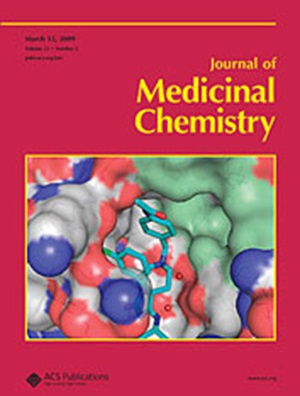一种新型原药能增强胰高血糖素样肽 1 的缓释和长期作用
IF 6.8
1区 医学
Q1 CHEMISTRY, MEDICINAL
引用次数: 0
摘要
生物活性肽作为治疗药物显示出许多有利的特性,但由于其代谢稳定性低和肾脏清除迅速,其使用具有挑战性。小分子量角器通过与血清白蛋白的非共价结合和对全身清除的保护而起作用,是延长多肽半衰期的有吸引力的工具。在此,我们研究了考马斯亮蓝(CBB)作为临床相关胰高血糖素样肽1 (GLP-1)半衰期延长的新量角器。描述了一系列GLP-1类似物与CBB连接物和酰化位置的区别。一种特别有趣的类似物(古马肽13)在体外表现出亚皮摩尔的效力,并在小鼠体内长期控制葡萄糖稳态。一项延长机制研究表明,CBB与白蛋白具有高亲和力,并与其他基质蛋白泛相互作用,能够在体循环和皮下储库中延长肽。我们的研究表明,对白蛋白的特异性亲和力不是肽延伸的先决条件,泛结合物可能是有利的。本文章由计算机程序翻译,如有差异,请以英文原文为准。

A New Protractor Potentiates Glucagon-Like Peptide 1 with Slow-Release Depot and Long-Term Action
Bioactive peptides display a number of favorable features as therapeutics, but their usage is challenging due to the low metabolic stability and rapid renal clearance. The small-molecule protractor, which functions by the noncovalent binding with serum albumin and protection against systemic clearance, is an attractive tool to elongate peptides’ half-life. Herein, we investigated coomassie brilliant blue (CBB) as a new protractor for the half-life extension of clinically relevant glucagon-like peptide 1 (GLP-1). A series of GLP-1 analogues differentiating with CBB linkers and acylation positions are described. One particularly interesting analogue (coomatide 13) exhibits sub-picomolar potency in vitro and long-term control of glucose homeostasis in mice. A protraction mechanism study reveals that CBB has a high affinity to albumin and pan-interaction with other matrix proteins, enabling to protract peptides in both systemic circulation and the subcutaneous depot. Our study demonstrates that the specific affinity to albumin is not a prerequisite for peptide protraction, and pan-binders might be advantageous.
求助全文
通过发布文献求助,成功后即可免费获取论文全文。
去求助
来源期刊

Journal of Medicinal Chemistry
医学-医药化学
CiteScore
4.00
自引率
11.00%
发文量
804
审稿时长
1.9 months
期刊介绍:
The Journal of Medicinal Chemistry is a prestigious biweekly peer-reviewed publication that focuses on the multifaceted field of medicinal chemistry. Since its inception in 1959 as the Journal of Medicinal and Pharmaceutical Chemistry, it has evolved to become a cornerstone in the dissemination of research findings related to the design, synthesis, and development of therapeutic agents.
The Journal of Medicinal Chemistry is recognized for its significant impact in the scientific community, as evidenced by its 2022 impact factor of 7.3. This metric reflects the journal's influence and the importance of its content in shaping the future of drug discovery and development. The journal serves as a vital resource for chemists, pharmacologists, and other researchers interested in the molecular mechanisms of drug action and the optimization of therapeutic compounds.
 求助内容:
求助内容: 应助结果提醒方式:
应助结果提醒方式:


